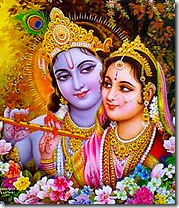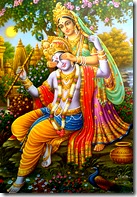Radhashtami
Posted by krishnasmercy on August 27, 2009
 "O Radha, you are dearer to me than my life even and I am like the same to you. There has been no point of separation or difference between us. Both of us have one and the same form." (Lord Krishna speaking to Radha just prior to their advent on earth, Brahmavaivarta Purana, Krishna-Janma Khand)
"O Radha, you are dearer to me than my life even and I am like the same to you. There has been no point of separation or difference between us. Both of us have one and the same form." (Lord Krishna speaking to Radha just prior to their advent on earth, Brahmavaivarta Purana, Krishna-Janma Khand)
Radhashtami is the appearance day celebration of Shrimati Radharani, the eternal consort of Lord Krishna. Just as we take our spouse to be our partner for life, God has a life partner in His eternal consorts. Though He has different forms and incarnations such as Rama, Narasimha, Varaha, etc., according to the Brahmavaivarta, Vishnu, and Bhagavata Puranas, Krishna is the original form of God. Krishna's immediate expansion and pleasure potency is Radharani, often referred to just as Radha.
Radha is known as Krishna's pleasure potency, hladini-shakti. Krishna is the energetic and Radha is His energy, similar to the way wives are referred to as the better-half of their husbands. She is completely engrossed in thoughts of Krishna, loving Him purely and perfectly. Actually, it is not possible for one to love Krishna more than Radha does, for out of all the gopis, she is Krishna's favorite. Just as there are various forms of Krishna, so there exist many expansions of Radha. All the great demigoddesses and the various Lakshmis are all considered to emanate from her. Radhashtami is celebrated because it marks the anniversary of when she took birth on this earth some five thousand years ago.
Just like Krishna, Radha is eternal, so she technically doesn't take birth in the material world. For this reason, the occasion of her birth is referred to as her appearance day. According to the different Puranas, there are several versions of the story relating to the circumstances of her appearance. The reason for this is that God reenacts His pastimes on earth over and over again in the different kalpas, or creations. The general story is that Radha, Krishna, and their associates were enjoying their pastimes on the spiritual planet of Krishnaloka, when a misunderstanding arose between Radha and Krishna's friend Shridama over Krishna's playing with one of the gopis. As a result, Shridama cursed Radha to appear on earth and be separated from Krishna for one hundred years. This coincided with Krishna's appearance on earth, the purpose of which was to kill the demon Kamsa and to deliver His dependents. Naturally whenever God comes to earth, He brings His closest associates with him.
Radharani appeared fifteen days after Krishna did, as the daughter of Vrishabhanu and Kirtida.
"The birth of Radharani was not from the womb of any human being. She was found by her father in the field. While father was plowing, he saw one little nice child is lying there, and he had no children, so he caught it and presented to the queen, 'Oh, here we have got a very nice child.' 'How you got?' 'Oh, in the field.' Just see. Radharani's janma is like that." (Shrila Prabhupada, Lecture, Montreal, Aug. 30, 1968)
As the tradition goes, Radha actually didn't open her eyes for the first few days, a fact which worried her parents. They were concerned that she might be blind, so they invited the venerable Narada Muni to come and assess the situation. He was immediately taken aback after seeing Radha, for he knew she was no ordinary child. He advised Vrishabhanu not to worry and to hold an elaborate feast and invite Nanda and Yashoda, the foster-parents of Krishna. When baby Krishna came over, He crawled to Radha's crib to look at her. When she finally opened her eyes, Krishna was the first person she saw.
 In their youth, the two enjoyed many wonderful pastimes in Vrindavana, but sadly the Lord would have to leave and finish His pastimes in Mathura and Dvaraka. Radha and the other gopis were left in Vrindavana always pining for the Lord. Such a separation may seem like a bad thing, but it actually brings about a pleasurable feeling. Worshiping the Lord in the mood of separation was the process recommended by Lord Chaitanya, for it is very blissful and arouses feelings of Krishna prema. Radhrani's separation anxiety was very great and she even declared that no one except Sita Devi, Lord Rama's wife, knew what she was experiencing.
In their youth, the two enjoyed many wonderful pastimes in Vrindavana, but sadly the Lord would have to leave and finish His pastimes in Mathura and Dvaraka. Radha and the other gopis were left in Vrindavana always pining for the Lord. Such a separation may seem like a bad thing, but it actually brings about a pleasurable feeling. Worshiping the Lord in the mood of separation was the process recommended by Lord Chaitanya, for it is very blissful and arouses feelings of Krishna prema. Radhrani's separation anxiety was very great and she even declared that no one except Sita Devi, Lord Rama's wife, knew what she was experiencing.
"This type of grief was known either to Sita or to me. Compared to me, there is no one else in the three worlds whose mind is so painful. Can any woman believe in my pain after looking at me? Oh son Uddhava, what other women have faced such a type of grief? Among women, there is no one who is so badly suffering like Radha, who is suffering from separation from her Lord and is devoid of fortune and is completely grief-stricken. There is no one else among the damsels feeling more painful at heart than Radhika. In this universe the husband who happens to be the kalpavriksha (wish-fulfilling tree) was achieved by me, but I have been deprived of the same because of cruel destiny. With one look at His lotus-like feet as well as His moon-like face and His costumes, my birth and my life have become successful. With the hearing of whose name all the life airs become activated and sprout like flowers and the soul is filled with affection, the one who touched me at the time of conjugal pleasure and with that I enjoyed the glory of the three worlds. How can I forget such a lord by getting any amount of riches?" (Radharani speaking to Krishna's friend and envoy Uddhava, Brahmavaivarta Purana, Krishna-Janma Khand)
There is no difference between God and His name. Merely thinking of Him and reciting His name means we are in direct association with Him. In this way, there is actually never any separation between the Lord and His devotees. Devotees typically fast until noon on Radhashtami and then have discussions about Radha and Krishna. The best way to celebrate the grand pair is to always call chant their holy names found in the maha-mantra: "Hare Krishna Hare Krishna, Krishna Krishna, Hare Hare, Hare Rama Hare Rama, Rama Rama, Hare Hare". Krishna is the original name of God and Hare refers to the Lord's energy in the form of Radha. Jai Shri Radhe!
--
Yours
Dinesh
Blog:http://dinesh-krsna.blogspot.com










